Psychotherapy for Obsessive Compulsive Disorder
Added on 2023-06-15
30 Pages9111 Words407 Views
PSYCHOTHERAPY FOR OBSESSIVE COMPULSIVE DISORDER
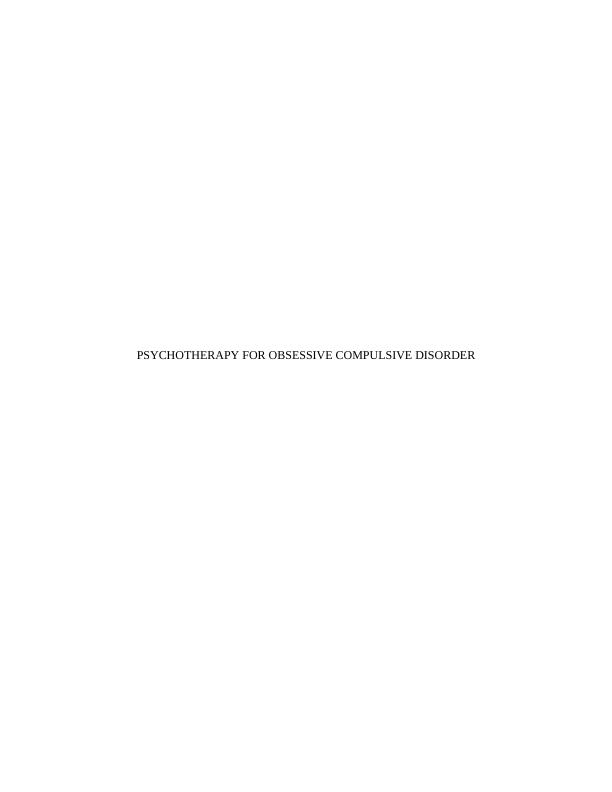
1
Table of Contents
Introduction......................................................................................................................................2
Client’s history.................................................................................................................................3
Assessment......................................................................................................................................3
Formulation......................................................................................................................................4
Treatment and rational Chosen........................................................................................................6
Criticism........................................................................................................................................16
Conclusion.....................................................................................................................................17
References......................................................................................................................................19
Appendix........................................................................................................................................24
Table of Contents
Introduction......................................................................................................................................2
Client’s history.................................................................................................................................3
Assessment......................................................................................................................................3
Formulation......................................................................................................................................4
Treatment and rational Chosen........................................................................................................6
Criticism........................................................................................................................................16
Conclusion.....................................................................................................................................17
References......................................................................................................................................19
Appendix........................................................................................................................................24
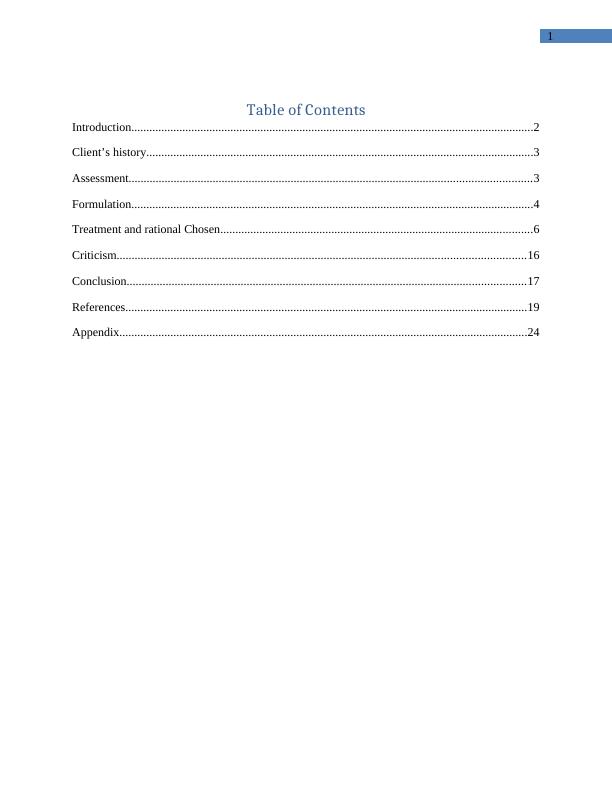
2
Introduction
Cognitive Behaviour Therapy (CBT) is identified as the tried and tested treatment for
almost any mental ailment (Newman et al. 2015). The Third Wave Therapy which is a new CBT
based intervention therapy including Meta-Cognitive Therapy (MCT) (Wells, 1995),
Mindfulness-Based Cognitive Therapy (Segal, Williams and Teasadale 2002), Compassion
Focused Therapy (Gilbert 2005) amongst others. While the third wave intervention methods
have a diversified approach, strengths and weaknesses, they still merge in their distinct
philosophical approaches of CBT as they are collaborative and therapeutic in nature using a
rational approach (Beck 2012).
In this case study, the application of CBT in the treatment of Obsessive Compulsive
Disorder (OCD) patient will be critically discussed. In addition, the application of MCT is
discussed as a third wave approach to the treatment of OCD will be fully examined and
rationalised.
The Case Study will aim to analyse the important information related to the client, which
includes the background history of the client in which the predicament of the client is discussed
along with its maintaining factors and the assessment tools to be used for the mitigation
intervention of the presenting problem while formulating of the underlying philosophy in context
to a chosen model. The different assessment tools deployed will help in the overall improvement
of the condition of the patients with the support of the different CBT tools. It will further
evaluate and rationalise the use of MCT base, CBT according to the requirements of the client.
Finally, the study will do a critical analysis of MCT based on literature and evidence to
recommend the development of the study regarding the present research.
The author currently works as a trainee CBT therapist in Central North West London
Trust (CNWL) supporting individuals with various mental health disorders such as anxiety,
depression, PSTD and OCD. It is important for the practitioner to maintain the confidentiality in
such treatments, so the patient will be referred as Mr Robert. Mr Robert was referred to me from
his GP, for the treatment of severe OCD using the Alternative CBT interventions. His disease
affects him, mentally, emotionally and physically causing issues in his daily social cycle. The
Introduction
Cognitive Behaviour Therapy (CBT) is identified as the tried and tested treatment for
almost any mental ailment (Newman et al. 2015). The Third Wave Therapy which is a new CBT
based intervention therapy including Meta-Cognitive Therapy (MCT) (Wells, 1995),
Mindfulness-Based Cognitive Therapy (Segal, Williams and Teasadale 2002), Compassion
Focused Therapy (Gilbert 2005) amongst others. While the third wave intervention methods
have a diversified approach, strengths and weaknesses, they still merge in their distinct
philosophical approaches of CBT as they are collaborative and therapeutic in nature using a
rational approach (Beck 2012).
In this case study, the application of CBT in the treatment of Obsessive Compulsive
Disorder (OCD) patient will be critically discussed. In addition, the application of MCT is
discussed as a third wave approach to the treatment of OCD will be fully examined and
rationalised.
The Case Study will aim to analyse the important information related to the client, which
includes the background history of the client in which the predicament of the client is discussed
along with its maintaining factors and the assessment tools to be used for the mitigation
intervention of the presenting problem while formulating of the underlying philosophy in context
to a chosen model. The different assessment tools deployed will help in the overall improvement
of the condition of the patients with the support of the different CBT tools. It will further
evaluate and rationalise the use of MCT base, CBT according to the requirements of the client.
Finally, the study will do a critical analysis of MCT based on literature and evidence to
recommend the development of the study regarding the present research.
The author currently works as a trainee CBT therapist in Central North West London
Trust (CNWL) supporting individuals with various mental health disorders such as anxiety,
depression, PSTD and OCD. It is important for the practitioner to maintain the confidentiality in
such treatments, so the patient will be referred as Mr Robert. Mr Robert was referred to me from
his GP, for the treatment of severe OCD using the Alternative CBT interventions. His disease
affects him, mentally, emotionally and physically causing issues in his daily social cycle. The
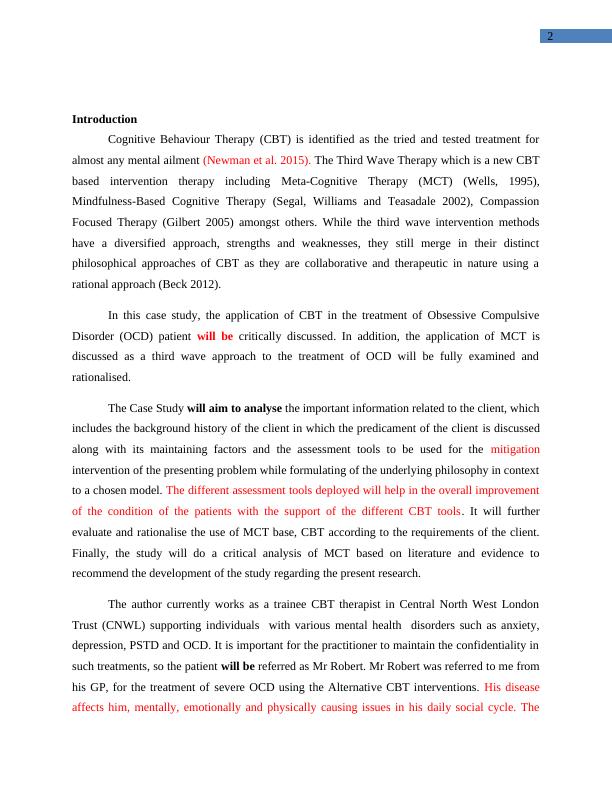
3
different habits he has acquired due to his anxiety and the panic in various situations causes him
to lose focus on his daily tasks, thereby affecting his life.
Client’s history
Mr Robert is now a 38 year old bachelor living with his 72-year-old mother. After being
diagnosed with OCD officially, he requested to be treated for it via through psychotherapy, as it
will eliminate any other mental disorders documented by the psychiatrist. He has been suffering
from OCD for a while and was taking medicines for it but asked for help as the medicines were
affecting his health.
The severity of the OCD of the client escalated after his mother was hospitalised and was
on life support due to an illness. In due time she recovered, but since the incident, he has
continuous intrusive, and aberrant thoughts fearing his mother would die, believing her sickness
resulted from contamination in his house, however his mother refused to accept the statement.
Mr Robert washes his hands as many as six times hourly to atone for his complex thoughts and
has spurts of severe anxiety if he does not do so. Even though, the number of times he washes his
hands has increased recently, the extreme handwashing resulted to breaking down of his skin,
leading to open wounds. He has also developed a habit of constant praying thinking this would
help the condition of the mother.
The constant visits to the washroom to wash his hands has also affected his job as a
computer engineer putting his relationship in significantly bad terms with the line manager, and
currently, he took sick leave for his treatment. The general physician is looking after his
reference for CBT considering the chronic nature of his affliction which was further worsened by
his mother’s illness.
Assessment
The rationale for the study assessment includes gaining the important information related
to Mr Robert for a better evaluation of his case, to ascertain the suitability of the CBT and form a
therapeutic relationship in collaboration with him. The important rationales of the CBT include:
inspecting suitability, collecting an authentic case history, evaluation of the extent or the
advancement of the disorder, establishment of a case conception for the overall treatment of the
different habits he has acquired due to his anxiety and the panic in various situations causes him
to lose focus on his daily tasks, thereby affecting his life.
Client’s history
Mr Robert is now a 38 year old bachelor living with his 72-year-old mother. After being
diagnosed with OCD officially, he requested to be treated for it via through psychotherapy, as it
will eliminate any other mental disorders documented by the psychiatrist. He has been suffering
from OCD for a while and was taking medicines for it but asked for help as the medicines were
affecting his health.
The severity of the OCD of the client escalated after his mother was hospitalised and was
on life support due to an illness. In due time she recovered, but since the incident, he has
continuous intrusive, and aberrant thoughts fearing his mother would die, believing her sickness
resulted from contamination in his house, however his mother refused to accept the statement.
Mr Robert washes his hands as many as six times hourly to atone for his complex thoughts and
has spurts of severe anxiety if he does not do so. Even though, the number of times he washes his
hands has increased recently, the extreme handwashing resulted to breaking down of his skin,
leading to open wounds. He has also developed a habit of constant praying thinking this would
help the condition of the mother.
The constant visits to the washroom to wash his hands has also affected his job as a
computer engineer putting his relationship in significantly bad terms with the line manager, and
currently, he took sick leave for his treatment. The general physician is looking after his
reference for CBT considering the chronic nature of his affliction which was further worsened by
his mother’s illness.
Assessment
The rationale for the study assessment includes gaining the important information related
to Mr Robert for a better evaluation of his case, to ascertain the suitability of the CBT and form a
therapeutic relationship in collaboration with him. The important rationales of the CBT include:
inspecting suitability, collecting an authentic case history, evaluation of the extent or the
advancement of the disorder, establishment of a case conception for the overall treatment of the
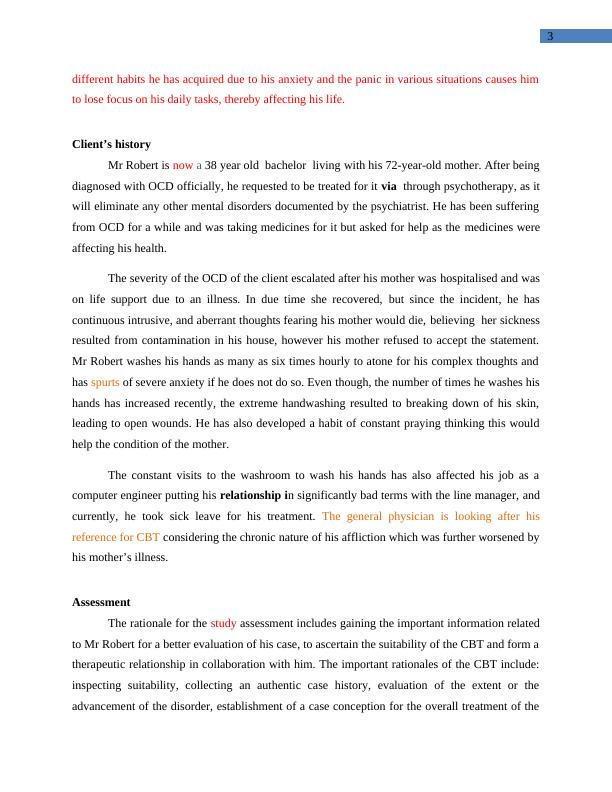
4
individual (Westbrook 2014). According to Abramowitz (2013), assessment focusses on the
understanding of the strengths and weakness of the individuals along with an in-depth analysis of
the problems faced by the person, triggered by the environment, behaviour, physical sensation
and thoughts. In addition, Will and Sanders (2013), postulate that having a complete idea of the
presenting factors in the analysis, improves the remedial relationship and mutual interaction with
the clients, which is extremely necessary for the treatment through CBT. Likewise, Leahy,
Holland and McGinn (2012) recognised that the evaluation improves the expression of empathy,
knowledge and acumen which are important elements in framing a therapeutic relationship.
The condition suitability of Robert was ascertained through several of questioning
sessions including the ability to rationalise that Robert could agree to therapy, to make sure if his
condition was perceptible, predictable, and he was able to agree with the therapists (Dryden and
Branch 2012). Robert is also informed of the whole components of CBT including setting
agendas, working in collaboration to develop a therapeutic relationship, assessment, formulation,
intervention, goal setting homework and prevention from relapse. Therefore, to work
collaboratively, the client will have a better understanding of the CBT model and the
intervention to be used for the treatment (Grant, 2010).
OCD is one of the most unnerving of the members of the anxiety family of disorders,
which is categorised can be understood by deep-seated and unwanted thoughts which are
unnecessary for the individuals and to compensate for these thoughts they have obsessional
habits. The in-depth evaluation in the case of Mr Robert was to make sure about the symptoms of
OCD along with its triggers and implications. In the UK almost one in every fifty individuals
suffers from OCD and the related issues in the society (Ocduk.org, 2018).
Formulation
Conceptualisation or Formulation in this type of psychotherapy process is the
comprehension of the situation according to Kuyken, Padesky and Dudley (2008). Similarly,
Steffen (2013) defines views formulation as a psychological map defining the patient’s current
problem, although the concept framing is disparate from the normally known problems of the
psychological analysis (Beck 2012). Salkovskis 1985 model of OCD was used to have a better
understanding of the type of issues faced by Robert in his OCD. Rees and Anderson (2013),
individual (Westbrook 2014). According to Abramowitz (2013), assessment focusses on the
understanding of the strengths and weakness of the individuals along with an in-depth analysis of
the problems faced by the person, triggered by the environment, behaviour, physical sensation
and thoughts. In addition, Will and Sanders (2013), postulate that having a complete idea of the
presenting factors in the analysis, improves the remedial relationship and mutual interaction with
the clients, which is extremely necessary for the treatment through CBT. Likewise, Leahy,
Holland and McGinn (2012) recognised that the evaluation improves the expression of empathy,
knowledge and acumen which are important elements in framing a therapeutic relationship.
The condition suitability of Robert was ascertained through several of questioning
sessions including the ability to rationalise that Robert could agree to therapy, to make sure if his
condition was perceptible, predictable, and he was able to agree with the therapists (Dryden and
Branch 2012). Robert is also informed of the whole components of CBT including setting
agendas, working in collaboration to develop a therapeutic relationship, assessment, formulation,
intervention, goal setting homework and prevention from relapse. Therefore, to work
collaboratively, the client will have a better understanding of the CBT model and the
intervention to be used for the treatment (Grant, 2010).
OCD is one of the most unnerving of the members of the anxiety family of disorders,
which is categorised can be understood by deep-seated and unwanted thoughts which are
unnecessary for the individuals and to compensate for these thoughts they have obsessional
habits. The in-depth evaluation in the case of Mr Robert was to make sure about the symptoms of
OCD along with its triggers and implications. In the UK almost one in every fifty individuals
suffers from OCD and the related issues in the society (Ocduk.org, 2018).
Formulation
Conceptualisation or Formulation in this type of psychotherapy process is the
comprehension of the situation according to Kuyken, Padesky and Dudley (2008). Similarly,
Steffen (2013) defines views formulation as a psychological map defining the patient’s current
problem, although the concept framing is disparate from the normally known problems of the
psychological analysis (Beck 2012). Salkovskis 1985 model of OCD was used to have a better
understanding of the type of issues faced by Robert in his OCD. Rees and Anderson (2013),
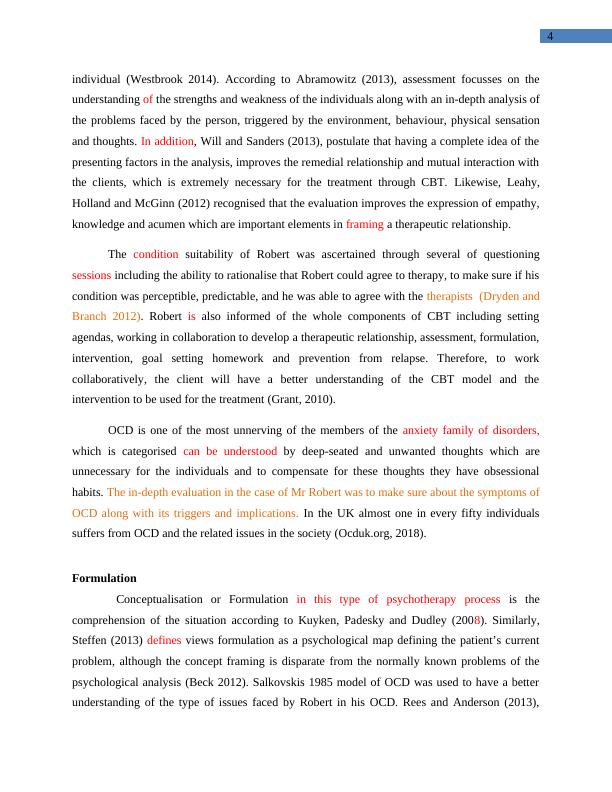
5
further emphasise on the fact that Cognitive behaviour models see clients with OCD having
different notions exaggerating the sense of anxiety. The Salkovsis 1985 model is one which has
been tried and tested in conceptualisation and intervention processes by many researchers as it
gives a more detailed scenario in the condition of OCD (Westbrook 2014; Berman et al. 2015).
Mr Robert was diagnosed with OCD at a young age which helped in managing it with the
help of the medicine prescribed by his GP. Mooney (2014) informs that OCD treatment with
medicine has been effective over the years. In the current scenario, although, Robert’s situation
deteriorated because his mother’s illness which triggers his anxiety. Since he blames himself for
the illness, it led to extreme anxiety, and therefore the constant handwashing ritual and praying
that he practised was a way to neutralise the anxiety. The formulation is represented in the form
of a diagram to show the causes and the course of his actions. Salkovski’s (1985) model alludes
that the situation of the OCD is in the understanding of perception by the patient and not the
thought itself, but its interpretation is the major reason of the anxiety in the patients. On the
contrary, McGinn and Sanderson (1999) suggest that the intrusive thoughts do not naturally
result to greater anxietycause anility. An in-depth study of OCD by Ladouceur, Gosselin and
Dugas (2000) proved that the increased sense of self-responsibility and blame increases the level
of anxiety in a person. Leahy et al. (2012), argued that the neutralino behaviour is no explanation
of the abnormally of the obsessions.
further emphasise on the fact that Cognitive behaviour models see clients with OCD having
different notions exaggerating the sense of anxiety. The Salkovsis 1985 model is one which has
been tried and tested in conceptualisation and intervention processes by many researchers as it
gives a more detailed scenario in the condition of OCD (Westbrook 2014; Berman et al. 2015).
Mr Robert was diagnosed with OCD at a young age which helped in managing it with the
help of the medicine prescribed by his GP. Mooney (2014) informs that OCD treatment with
medicine has been effective over the years. In the current scenario, although, Robert’s situation
deteriorated because his mother’s illness which triggers his anxiety. Since he blames himself for
the illness, it led to extreme anxiety, and therefore the constant handwashing ritual and praying
that he practised was a way to neutralise the anxiety. The formulation is represented in the form
of a diagram to show the causes and the course of his actions. Salkovski’s (1985) model alludes
that the situation of the OCD is in the understanding of perception by the patient and not the
thought itself, but its interpretation is the major reason of the anxiety in the patients. On the
contrary, McGinn and Sanderson (1999) suggest that the intrusive thoughts do not naturally
result to greater anxietycause anility. An in-depth study of OCD by Ladouceur, Gosselin and
Dugas (2000) proved that the increased sense of self-responsibility and blame increases the level
of anxiety in a person. Leahy et al. (2012), argued that the neutralino behaviour is no explanation
of the abnormally of the obsessions.
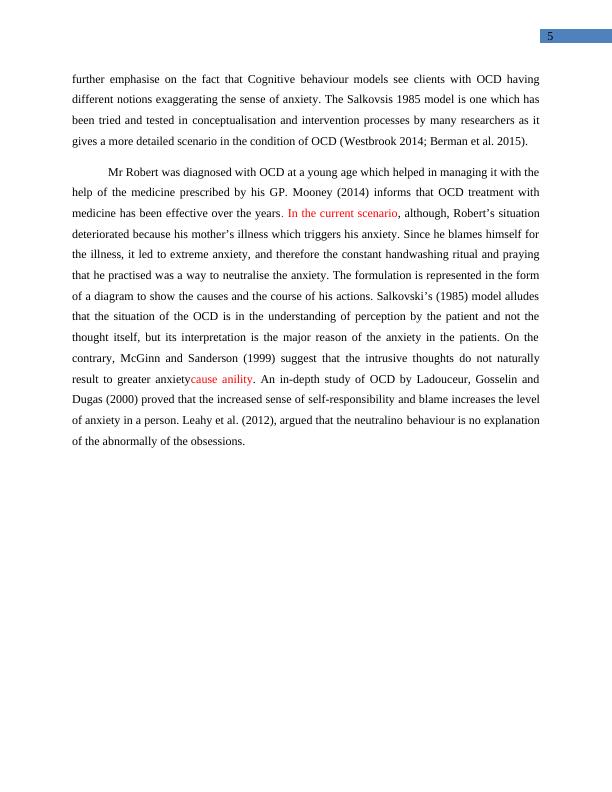
End of preview
Want to access all the pages? Upload your documents or become a member.
Related Documents
Panic Disorder: Symptoms, Prevalence, Treatment and Current Researchlg...
|11
|1080
|406
Case Study on Women Dina Who is Suffering from Obsessive Compulsive Disorderlg...
|5
|1045
|440
CBT and Existential Therapy: A Comparative Analysislg...
|9
|2694
|302
Cognitive Behavioural Therapy Assignment Reportlg...
|11
|3018
|20
Treatment Options and Nursing Interventions for Mental Health Disorderslg...
|8
|2200
|167
Cognitive Behavior Therapy (CBT) - An Overview, Strengths and Limitationslg...
|18
|5245
|363
